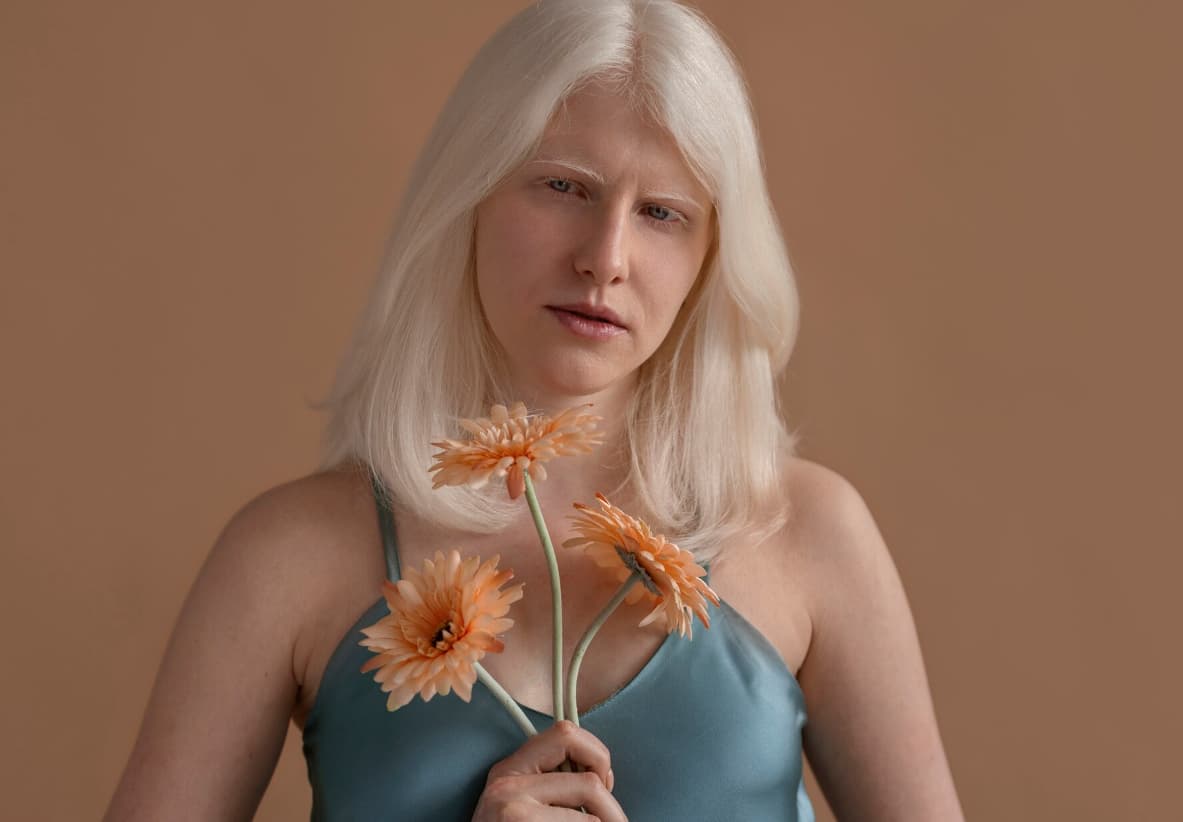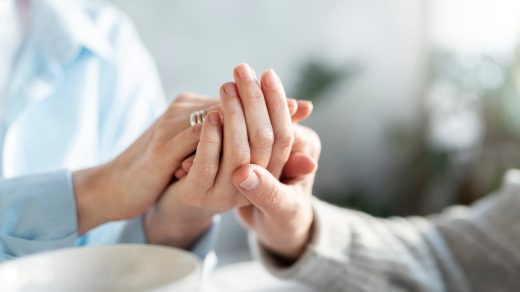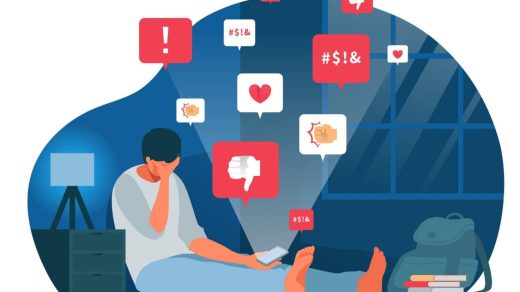Have you ever seen someone with strikingly pale skin and very light hair? You might have encountered a person with albinism.
This rare genetic condition affects people from all backgrounds and has fascinated scientists and the public alike for centuries.
But what exactly is albinism? How does it occur, and what does it mean for those who have it?
In this comprehensive guide, we’ll dive deep into the world of albinism. We’ll explore its causes, uncover the various types, and look at real-life pictures to understand its visual impact.
We’ll also discuss the symptoms that people with albinism experience and how they navigate daily life.
Whether you’re curious about this condition, know someone with albinism, or have it yourself, this article aims to provide clear, easy-to-understand information.
Albinism

We’ll break down complex medical terms and explain everything in simple language. So, are you ready to learn about this unique genetic trait that affects thousands of people worldwide?
Let’s begin our journey into understanding albinism!
What is Albinism?
Albinism is a condition some people are born with. It affects how much color their body makes. This color is called melanin.
People with albinism don’t make enough melanin, or sometimes they don’t make any at all.
Melanin gives color to our:
- Skin
- Hair
- Eyes
When someone doesn’t have much melanin, they might have:
- Very light skin
- White or very light hair
- Light-colored eyes
Albinism is pretty rare. In the United States, about 1 in every 18,000 to 20,000 people has it.
That means in a big city of 1 million people, there might be about 50 to 55 people with albinism.
What Causes Albinism?
Albinism is something you’re born with. It’s not a disease you can catch from someone else.
It’s all about genes. Genes are like instruction books in our bodies that tell our bodies how to grow and work.
Here’s how it happens:
- Everyone has genes from both their mom and dad.
- Sometimes, these genes have small mistakes in them.
- If both parents have a gene with a mistake that affects melanin, their child might have albinism.
Most of the time, parents of a child with albinism don’t have albinism themselves. They just carry the gene that can cause it.
Types of Albinism
There are several types of albinism. Each type is caused by a different gene mistake. Let’s look at the main types:
1. Oculocutaneous Albinism (OCA)
This is the most common type. It affects the skin, hair, and eyes. There are different subtypes of OCA:
- OCA1
- OCA1a: People with this have no melanin at all. They have white hair, very pale skin, and light eyes.
- OCA1b: People with this make a little melanin. They have light skin, hair, and eyes, but not as light as OCA1a.
- OCA2
- This is less severe than OCA1.
- People with OCA2 might have yellow, blond, or light brown hair.
- It’s more common in people with African or Native American backgrounds.
- OCA3
- This usually affects people with dark skin.
- People with OCA3 often have reddish-brown skin, reddish hair, and hazel or brown eyes.
- OCA4
- This is similar to OCA2.
- It’s more common in people with East Asian backgrounds.
2. Ocular Albinism
This type mainly affects the eyes. It doesn’t change skin or hair color much. It’s rare and usually only affects boys.
3. Hermansky-Pudlak Syndrome
This is a rare type of albinism. People with this also have problems with their lungs, intestines, and blood clotting.
4. Chediak-Higashi Syndrome
This is another rare type. People with this have a higher chance of getting infections.
5. Griscelli Syndrome
This is extremely rare. It affects the color of skin and hair, but also causes problems with the immune system and brain.
Symptoms of Albinism
People with albinism might have:
- Skin • Very pale or white skin • Skin that burns easily in the sun
- Hair • White, yellow, or light-colored hair • Hair on the body might also be very light
- Eyes • Light blue, gray, or brown eyes • Eyes that look pink or red in certain lights
- Vision Problems • Being very sensitive to light • Eyes that move back and forth quickly (doctors call this nystagmus) • Not being able to see things far away very well • Eyes that don’t look in the same direction (crossed eyes)
It’s important to remember that not everyone with albinism will have all these symptoms. It depends on the type of albinism they have.
How is Albinism Diagnosed?
Doctors can tell if someone has albinism in a few ways:
- Looking at Symptoms • A doctor will look at the person’s skin, hair, and eyes. • They’ll ask about any vision problems.
- Eye Tests • Special tests can show if the eyes are working differently because of albinism.
- Genetic Testing • This is the most accurate way to diagnose albinism. • It involves taking a small blood sample and looking at the genes.
Is There a Treatment for Albinism?
There’s no cure for albinism, but there are ways to help with the symptoms:
| Is There a Treatment for Albinism? | |
|---|---|
| There’s no cure for albinism, but there are ways to help with the symptoms: | |
| Treatment Area | Methods |
| 1. Protecting the Skin | • Using strong sunscreen • Wearing clothes that cover the skin • Avoiding being out in strong sunlight |
| 2. Helping with Vision | • Wearing sunglasses to protect eyes from bright light • Using special glasses to help see better • Sometimes, surgery can help with eye problems |
| 3. Regular Check-ups | • Seeing an eye doctor regularly • Checking the skin for any problems |
What’s the Long-term Outlook?
Most people with albinism live just as long as anyone else. They can do most things other people can do, but they need to be extra careful about sun protection.
Some rare types of albinism, like Hermansky-Pudlak syndrome, can cause other health problems. People with these types might need extra medical care.
Living with Albinism
Living with albinism can be challenging, but many people with the condition lead happy, successful lives. Here are some things that can help:
- Sun Protection • Always use sunscreen • Wear hats and long sleeves outside • Avoid being in the sun during the middle of the day
- Vision Care • Use low vision aids when needed • Learn techniques to deal with vision challenges
- Education • Work with teachers to make sure school materials are easy to see • Sit close to the front of the classroom
- Support • Join support groups for people with albinism • Talk to others who understand the challenges
- Self-Esteem • Remember that albinism is just one part of who you are • Celebrate your unique appearance
Frequently Asked Questions
- Q: Can people with albinism have children?
A: Yes, people with albinism can have children. Their children may or may not have albinism, depending on their partner’s genes.
- Q: Do people with albinism have red eyes?
A: Their eyes might look red or pink in certain lights, but they’re usually light blue, gray, or brown.
- Q: Can albinism be cured?
A: There’s no cure for albinism, but symptoms can be managed.
- Q: Is albinism contagious?
A: No, albinism is genetic. You can’t catch it from someone else.
- Q: Can people with albinism go out in the sun?
A: Yes, but they need to be very careful. They should use strong sunscreen and protective clothing.
Also Check:
Conclusion:
Albinism is a rare condition that affects the color of a person’s skin, hair, and eyes. It’s caused by genes and can’t be caught or cured.
People with albinism might look different and have some vision problems, but they can live full, happy lives.
The most important things for people with albinism are:
- Protecting their skin and eyes from the sun
- Getting help with vision if needed
- Understanding that being different is okay
Remember, everyone is unique in their way. Albinism is just one way that some people are special.
By learning about albinism, we can better understand and support people who have it.
Sources:
| Source | Link |
|---|---|
| Adams DR, et al. (2019). One-year pilot study on the effects of nitisinone on melanin in patients with OCA-1B. | https://insight.jci.org/articles/view/124387 |
| Ajitkumar A, et al. (2021). Chediak Higashi syndrome. | https://www.ncbi.nlm.nih.gov/books/NBK507881 |
| Albinism. (2020). | https://aapos.org/glossary/albinism |
| Albinism. (2020). | https://www.nhs.uk/conditions/albinism |
| Federico JR, et al. (2020). Albinism. | https://www.ncbi.nlm.nih.gov/books/NBK519018 |
| Griscelli syndrome. (2018). | https://www.orpha.net/consor/cgi-bin/OC_Exp.php?Expert=381&lng=EN |
| Information bulletin — What is albinism? (n.d.). | https://www.albinism.org/information-bulletin-what-is-albinism |
| Oculocutaneous albinism. (2015). | https://medlineplus.gov/genetics/condition/oculocutaneous-albinism |


